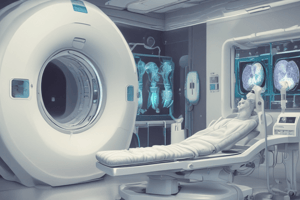Podcast
Questions and Answers
The CT imaging system is capable of achieving precision consistently due to its simple electronic mechanical design.
The CT imaging system is capable of achieving precision consistently due to its simple electronic mechanical design.
False (B)
Spatial uniformity in a CT image can be tested using an external software package.
Spatial uniformity in a CT image can be tested using an external software package.
False (B)
A CT image with acceptable spatial uniformity will have all values of the histogram or line graph within one standard deviation of the mean value.
A CT image with acceptable spatial uniformity will have all values of the histogram or line graph within one standard deviation of the mean value.
False (B)
The 'cupping' artifact in a CT image is caused by a decrease in CT numbers at the periphery of the image.
The 'cupping' artifact in a CT image is caused by a decrease in CT numbers at the periphery of the image.
The CT imaging system can be adjusted to ensure a zero value in the reconstructed image.
The CT imaging system can be adjusted to ensure a zero value in the reconstructed image.
The CT numbers of a water bath image will vary in different regions due to spatial non-uniformity.
The CT numbers of a water bath image will vary in different regions due to spatial non-uniformity.
Noise appears on the image as a blur.
Noise appears on the image as a blur.
High-noise images appear very smooth to the eye.
High-noise images appear very smooth to the eye.
CT imaging systems can only identify an ROI on the digital image.
CT imaging systems can only identify an ROI on the digital image.
The ROI for measuring noise must encompass at least 50 pixels.
The ROI for measuring noise must encompass at least 50 pixels.
CT number calibration is only required for new CT imaging systems.
CT number calibration is only required for new CT imaging systems.
The five-pin performance test object is used to measure noise in CT imaging systems.
The five-pin performance test object is used to measure noise in CT imaging systems.
Uniformity is calculated using the sum of the mean CT number in the centre and that at the periphery of the image.
Uniformity is calculated using the sum of the mean CT number in the centre and that at the periphery of the image.
When a uniform object is imaged, each pixel should have a different value.
When a uniform object is imaged, each pixel should have a different value.
CT image quality is not affected by the radiation dose received by the patient.
CT image quality is not affected by the radiation dose received by the patient.
A CT image with a high noise level appears very smooth to the eye.
A CT image with a high noise level appears very smooth to the eye.
The ability to image low-contrast objects with CT is not limited by the size and uniformity of the object.
The ability to image low-contrast objects with CT is not limited by the size and uniformity of the object.
The contrast resolution provided by CT is worse than that available in radiography.
The contrast resolution provided by CT is worse than that available in radiography.
Noise is measured by the average value of CT numbers in a defined area of the image.
Noise is measured by the average value of CT numbers in a defined area of the image.
The standard deviation of CT number values within a region of interest is symbolized by σ.
The standard deviation of CT number values within a region of interest is symbolized by σ.
Pixel size does not affect the noise in a CT image.
Pixel size does not affect the noise in a CT image.
Flashcards are hidden until you start studying
Study Notes
CT Imaging System Adjustments
- In an ideal CT imaging system, the pixel values should be zero when imaging a water bath.
- However, due to the complexity of the system, this precision is not consistently possible.
Spatial Uniformity
- Spatial uniformity can be tested by imaging a water bath and plotting CT numbers along any axis of the image as a histogram or line graph.
- If all values are within two standard deviations of the mean value (±2 σ), the system exhibits acceptable spatial uniformity.
Noise in CT Imaging
- Noise appears on the image as graininess, with low-noise images appearing smooth and high-noise images appearing spotty or blotchy.
- Noise is given by the variation of CT numbers from a mean value in a defined area of the image of a uniform phantom.
- Its magnitude is equal to the standard deviation of the CT number values within the region of interest.
Noise Measurement
- Noise should be evaluated daily through imaging of a 20-cm-diameter water bath.
- The ROI should encompass at least 100 pixels for noise measurement.
Linearity
- CT imaging systems must be calibrated frequently to consistently represent water by CT number zero and other tissues by appropriate CT numbers.
- A daily check calibration can be made using the five-pin performance test object of the American Association of Physicists in Medicine (AAPM).
Uniformity
- Uniformity is defined as the consistency of the CT numbers of an image of a homogeneous material across the scan field.
- Uniformity is calculated using the equation: ∣(CTm,c) - (CTm,p) ∣, which is the difference in the mean CT number in the centre from that at the periphery of the image.
Studying That Suits You
Use AI to generate personalized quizzes and flashcards to suit your learning preferences.




